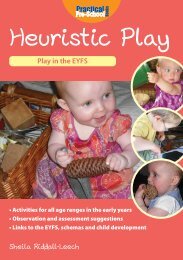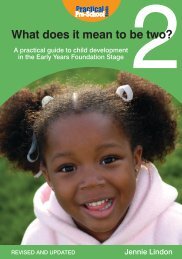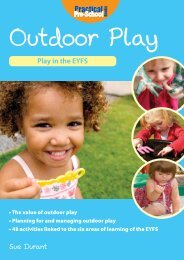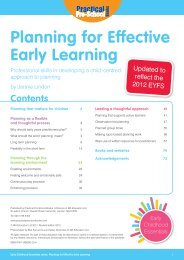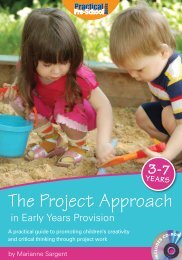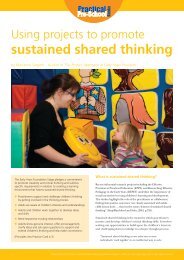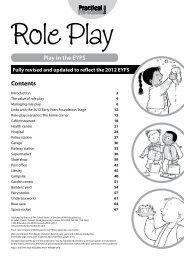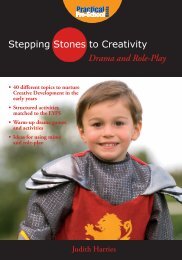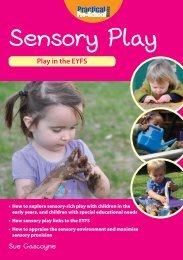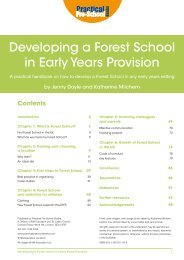What does it mean to be one? - Practical Pre-School Books
What does it mean to be one? - Practical Pre-School Books
What does it mean to be one? - Practical Pre-School Books
You also want an ePaper? Increase the reach of your titles
YUMPU automatically turns print PDFs into web optimized ePapers that Google loves.
Focus on <strong>one</strong> year olds<br />
Focus on <strong>one</strong>-year-olds<br />
<strong>What</strong> Does <strong>it</strong> Mean <strong>to</strong> <strong>be</strong> One? explores the developmental needs and likely skills of babies and<br />
young <strong>to</strong>ddlers. This book is part of a series that considers a year at a time in the life of very young<br />
children. This t<strong>it</strong>le now takes the series in<strong>to</strong> the very <strong>be</strong>ginning of early childhood and links<br />
closely w<strong>it</strong>h <strong>What</strong> <strong>does</strong> <strong>it</strong> <strong>mean</strong> <strong>to</strong> <strong>be</strong> two? The approach and ideas of this book are relevant <strong>to</strong> any<br />
pract<strong>it</strong>i<strong>one</strong>rs, working w<strong>it</strong>h babies and <strong>to</strong>ddlers anywhere in the UK. The structure of the book,<br />
however, follows the framework for England of the Early Years Foundation Stage: guidance covering<br />
from birth <strong>to</strong> five years of age that <strong>be</strong>came statu<strong>to</strong>ry for early years provision from Septem<strong>be</strong>r 2008.<br />
Children’s learning can only <strong>be</strong> effectively and appropriately supported when adults – pract<strong>it</strong>i<strong>one</strong>rs<br />
and parents alike – are guided by sound knowledge of child development. The layout of each of the<br />
five books in this linked series includes:<br />
• Descriptive developmental information w<strong>it</strong>hin the main text, organised w<strong>it</strong>hin the<br />
six areas of learning used by the Early Years Foundation Stage.<br />
• ‘For example’ sections giving instances of real children and real places and<br />
sometimes references <strong>to</strong> useful sources of further examples.<br />
• ‘Being a helpful adult’ boxes which focus on adult <strong>be</strong>haviour that is an effective support<br />
for children’s learning, as well as approaches that could undermine young children.<br />
• ‘Food for thought’ headings which highlight points of good practice in ways that<br />
can encourage reflection and discussion among pract<strong>it</strong>i<strong>one</strong>rs, as well as sharing in<br />
partnership w<strong>it</strong>h parents.<br />
<strong>What</strong><br />
<strong>does</strong><br />
<strong>it</strong> <strong>mean</strong> <strong>to</strong><br />
<strong>be</strong><br />
<strong>one</strong>?<br />
<br />
<strong>What</strong><br />
<strong>does</strong><br />
<strong>it</strong> <strong>mean</strong><br />
<strong>to</strong><br />
<strong>be</strong><br />
<strong>one</strong>?




